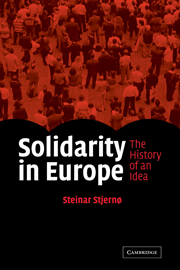Book contents
- Frontmatter
- Contents
- List of tables
- Acknowledgements
- List of abbreviations
- Introduction: to study the idea of solidarity
- Part I Three traditions of solidarity
- Part II The idea of solidarity in politics in Western Europe
- 4 European variations of solidarity discourses in social democracy
- 5 A comparative perspective on social democratic solidarity
- 6 The great challenger: the Christian democratic idea of solidarity
- 7 The languages of modern social democratic and Christian democratic solidarity
- 8 Two excursions: Marxist–Leninist and fascist solidarity
- Part III The present precariousness of solidarity
- References
- Index
8 - Two excursions: Marxist–Leninist and fascist solidarity
Published online by Cambridge University Press: 29 March 2010
- Frontmatter
- Contents
- List of tables
- Acknowledgements
- List of abbreviations
- Introduction: to study the idea of solidarity
- Part I Three traditions of solidarity
- Part II The idea of solidarity in politics in Western Europe
- 4 European variations of solidarity discourses in social democracy
- 5 A comparative perspective on social democratic solidarity
- 6 The great challenger: the Christian democratic idea of solidarity
- 7 The languages of modern social democratic and Christian democratic solidarity
- 8 Two excursions: Marxist–Leninist and fascist solidarity
- Part III The present precariousness of solidarity
- References
- Index
Summary
Between the two world wars both social democratic and Catholic solidarity were confronted with two rival conceptions of solidarity. The Russian revolution resulted in the establishment of communist parties and the development of the Marxist–Leninist ideology which continued the Marxist tradition and saw class as a foundation for solidarity. From the right, fascism formulated an idea of solidarity that erased the dividing lines between classes that Marxism saw as antagonistic, and established the nation and the race as the basis for solidarity. These alternative ways of defining solidarity were anchored in two different political languages, although a common characteristic was that they both excluded some of the key ideas in social democracy and Christian democracy, like freedom, democracy and individual rights.
Marxist-Leninist solidarity
In Chapter 2, we saw that Lenin evaded ideas that entailed feelings and ethics and that this also applied to the concept of solidarity, even if the concept of unity represented an equivalent in his political language. Nonetheless, Lenin's disciple, Georg Lukács, formulated a consistent concept of solidarity that was characterised by a strong collective orientation: solidarity should mean that the individual subordinated himself to the collective will of the communist party. Since freedom in a capitalist society was illusionary, individual freedom could be postponed to the new society after the revolution.
- Type
- Chapter
- Information
- Solidarity in EuropeThe History of an Idea, pp. 265 - 284Publisher: Cambridge University PressPrint publication year: 2005

